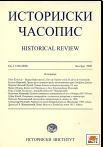Време настанка Ајнхардовог дела Vita Caroli imperatoris
The Date of Composition of Einhard’s Vita Caroli imperatoris
Author(s): Tibor ŽivkovićSubject(s): History
Published by: Istorijski institut, Beograd
Keywords: Einhard; Charles the Great; Louis the Pious; Hilduin
Summary/Abstract: On the basis of a section of Einhard’s Preface, stating that the author composed his work rather hastily, one can assume that it was ordered. Dynastic connotation, present in the first four chapters, as well as the mention of the issues regarding the dynastic legitimity could only signify that the actual ruler, Louis the Pious, instructed Einhard to compose this work. Chronological data that were examined in the previous section of the work indicate that it should not be dated prior to December 817, i.e. before Bernard’s rebellion. The mention of Arabian devastation of Italy, that had occurred only “recently” (in 813) – point to the conclusion that this could most probably encompass the period of two or three years and thus be dated to 815 or 816. The author’s allusion to the malevolent omen, relevant to the final years of Charles’ reign (demonstrated in collapse of the wooden construction that connected the court and basilica in Aachen) - could certainly not have been written if Einhard had already had the knowledge of the similar event that occurred in spring 817, when the emperor himself got injured, since that would have represented the malevolent omen for Louis. Failing to mention the second Louis’ coronation by the pope Stephen IV in Reims would probably suggest that the VC originated before October 816. Therefore, the wider context in which the work was composed should be dated to the period ranging from February 814 to September 816. Yet another important event stays intrinsically related to the proposed chronology – the special attention that the emperor has shown towards Einhard and his spouse Emma. As it has already been stated in the text, Louis the Pious donated two villages to Einhard on 11th January 815 – Michelstadt and Millinheim. It was in Millinheim that Einhard would later build his church and bring the relics of St. Marcellinus and St. Peter. Einhard was appointed secular abbot of St. Peter in Ghent as well as in the Bavo abbey the same year (815), whereas he received the Fontenel abbey the following year. These gifts that Einhard received between January 815 and the end of 816 might primarily be interpreted as a reward for certain deeds he has done in emperor’s favour. VC might be a reason – the literary work Louis the Pious ordered Einhard to compose. For instance, Einhard received the two abbeys from the emperor on 11th January 815 – upon the completion of the VC. The date is equally important. In other words, the work was finalized almost exactly on the anniversary of death of Charles the Great – in early 815 (Charles died on 28th January 814). At that very time, Gervard also sojourned in Ghent and thus received a copy of VC containing Einhard’s preface as a gift, immediately after the work was completed, i.e. in 815.
Journal: Историјски часопис
- Issue Year: 2011
- Issue No: 60
- Page Range: 25-56
- Page Count: 32
- Language: Serbian

